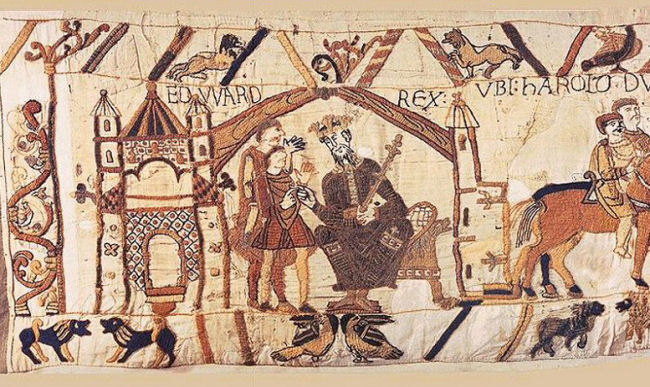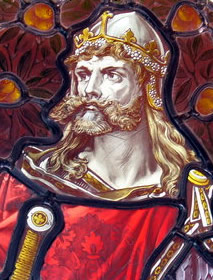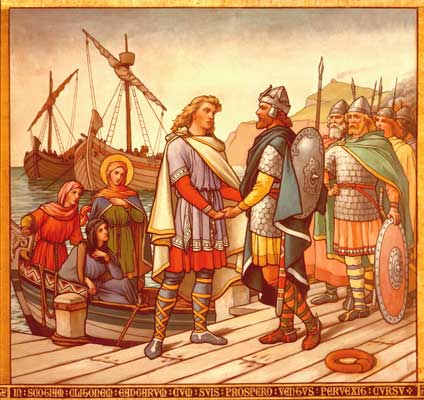Edgar was the Rightful King
When Edward the Confessor, a gentle, pious king, who left no direct heirs, died on January 5, 1066, there were several candidates to become King of England in his place. One thing to keep in mind: under English law, no one, not even the king, could promise the crown to anyone. That was for the Witan, a council of nobles and spiritual leaders, to decide. What was the Witan to do?
In England, Harold Godwinson, Earl of Wessex, wanted the job. But he was only Edward’s brother-in-law. Harold claimed Edward had given the throne to him on his deathbed. And so he might have done, even though he was thought to have murdered Edward’s brother.
In Norway, King Harald Hardrada had inherited land in England from King Canute who had once been King of England. Hardrada believed this meant he had a claim to be the King of England. Well, why not? After all, he was supported by Tostig, Harold of Wessex’s brother and Hardrada was already the powerful King of Norway. And he was planning to take England by force if he must.
There was another Scandinavian king who had a claim to the throne, too. King Sweyn of Denmark’s uncle had been Canute the Great, King of England, Denmark and Norway. Canute was ruling England when Edward took over. But Sweyn waited until Hardrada was defeated in his claim, then took his time to rally his hundreds of longships and fighting men. The Danes did not arrive in England until 1069, but more about that in my novel, Rogue Knight.
Meanwhile, across the English Channel lay Normandy and William, the bastard son of Robert, Duke of Normandy. William, now the duke, was Edward’s first cousin’s son. Seems a stretch to me, but this guy had ambition. And he had already demonstrated he was ruthless in battle. Besides all that, he told some tale about Edward having promised him the crown of England. But it seems Edward promised the crown to many, so what was that? William also claimed that Harold of Wessex had vowed to help him become king one day. Not sure about that and neither are the historians but then William’s folks wrote most of the history so there you have it.
As his father’s heir and now Duke of Normandy, William was used to ruling a large land. Why not more? So, William the Bastard planned to invade England just like Harald Hardrada. The plot thickens.
So what happened? The Witan named Harold of Wessex king. But we all know what happened to him…
Harald Hardrada invaded the north of England. King Harold fought him off. Weakened by the battle they’d just fought, Harold’s men trudged south to meet William the Bastard at Hastings where his men were storming ashore from Normandy. In a daylong battle, Harold was killed.
But one claimant to the throne of England remained… an heir of Edward’s. Indeed, Edgar Ætheling was the rightful heir to the throne. “Ætheling” is an Old English term used in Anglo-Saxon England to designate the princes of the royal dynasty eligible for the kingship. And so Edgar was. His father, Edmund Ironside, was King Edward’s half brother until he was killed, some say by poisoning. Unfortunately, when King Edward died, Edgar was only 14 or 15, a bit young to be leading soldiers and fighting off contenders for the crown.
Nevertheless, upon King Harold’s death, Edgar was named king, but he was never crowned because William the Bastard, earning his name as “the Conqueror”, moved in and took over.
Although Edgar had many supporters and, in 1069, joined with the Danes and the rebels in Yorkshire in a bid to reclaim England, through a series of fiascos, their fight was unsuccessful.
Edgar, his mother and two sisters fled to Scotland where King Malcolm welcomed them. And that is where Edgar enters my newest medieval romance, Rebel Warrior, set in Scotland in 1072.
By then, Edgar was 21 and though the rightful king, he would be denied his legacy. But one day his family would regain the throne in a manner of speaking. Edgar’s niece, Edith, daughter of Edgar’s sister Margaret who married the King of Scots, would become Queen of England, marrying Henry I.
If you want to see Edgar and his beautiful sister Margaret in Scotland, you will have to read Rebel Warrior!
“Master storytelling transports you to medieval Scotland!”
— Paula Quinn, NY Times Bestselling Author
About Rebel Warrior
When your destiny lies far from where you began…
Scotland 1072
The Norman Conqueror robbed Steinar of Talisand of his noble father and his lands, forcing him to flee to Scotland while still recovering from a devastating wound. At the royal court, Steinar becomes scribe to the unlettered King of Scots while secretly regaining his skill with a sword.
The first time Steinar glimpses the flame-haired maiden, Catrìona of the Vale of Leven, he is drawn to her spirited beauty. She does not fit among the ladies who serve the devout queen. Not pious, not obedient and not given to stitchery, the firebrand flies a falcon! Though Catrìona captures Steinar’s attention, he is only a scribe and she is promised to another.
Catrìona has come to Malcolm’s court wounded in spirit from the vicious attack on her home by Northmen who slayed her parents and her people. But that is not all she will suffer. The man she thought to wed will soon betray her.
When all is lost, what hope is there for love? Can a broken heart be mended? Can a damaged soul be healed?
Rebel Warrior on Amazon:
About the Author
 Regan Walker is an award-winning, #1 bestselling, multi-published author of Regency, Georgian and Medieval romance. She has five times been featured on USA TODAY’s HEA blog and twice nominated for the prestigious RONE award (her novel, The Red Wolf’s Prize won Best Historical Novel for 2015 in the medieval category). Regan writes historically authentic novels with real history and real historic figures where her readers experience history, adventure and love.
Regan Walker is an award-winning, #1 bestselling, multi-published author of Regency, Georgian and Medieval romance. She has five times been featured on USA TODAY’s HEA blog and twice nominated for the prestigious RONE award (her novel, The Red Wolf’s Prize won Best Historical Novel for 2015 in the medieval category). Regan writes historically authentic novels with real history and real historic figures where her readers experience history, adventure and love.






L
LikeLike
Sorry about that. Looks like an awesome read.
LikeLike
Thanks, Charlene. I do hope you like my series and the newest, Rebel Warrior.
LikeLike
With all the treachery of court I wouldn’t of wanted to be any title that had to be there lol.
LikeLike
England has always been a dangerous place for anyone who wanted to be king. You are so right! But I hope you will find the history in my romances interesting nonetheless.
LikeLike
A great post thank you. The Bayeux Tapestry always amazes me.
LikeLike
Thanks, Mary! It was an interesting time in history.
LikeLike
I’ve always loved the history surrounding The Conqueror and that period. You tell a fascinating tale.
LikeLike
Have you read my stories set in this time, Rue?
LikeLike
Not my period, but even so I’m surprised by my ignorance! Obviously William the Bastard was not the sort of man you ignored–but the Scots twist I had not known anything about. Most intriguing, Regan!
LikeLike
Glad you found it of interest, Beppie. And thanks for stopping by!
LikeLike
Thanks for having me as a guest on your lovely blog, Susana.
LikeLike
My pleasure, Regan. I always love your posts!
LikeLike
I enjoyed this so much. I love the history. This sounds like it would be an awesome read.
LikeLiked by 1 person
Thanks so much Tanja. I’m pleased you enjoyed the post. I hope you Rebel Warrior, too.
LikeLike
Thanks I really enjoyed it and learning about different topics.
LikeLiked by 1 person
You can learn a lot from my books, or so my readers tell me! Thanks for commenting.
LikeLike
I’ve read all three (so far) of the “Medieval Warriors” series, and I would recommend EVERYONE read them. They are one of the most FANTASTIC series I’ve read, and believe me, I’ve read a lot. You can’t go wrong reading a Regan Walker story!!
LikeLiked by 1 person
bevmg, you certainly made my day! I am so glad you like my stories. It’s readers like you who keep me writing (and doing the hard research!). Thanks so much.
LikeLiked by 1 person
interesting info
LikeLike
There are quite a few inaccuracies here in the story. Its my favourite period and ok, I may be a pedant, so please forgive me for pointing them out.
Number 1, Harold was not the man accused of killing Edward’s brother, that was Harold’s father, Godwin.
Number 2, where does it say in any of the chronicles that Hardrada inherited land in England? Nowhere.
Number 3, Canute was not ruling England when Edward took over, he’d been dead for a few years and there had been two other kings in between, his sons, Harold Harefoot and Harthacnut.
Number 4,William was Edward’s second cousin. Edward’s mother, Emma, was William’s great aunt.
Number 5, Edgar’s father was not Edmund Ironside, Edmund was Edgar’s grandfather. Edgar’s father was called Edward the Exile who was Edmund’s son.
LikeLike
Thank you for your historical factoids, Paula. I am not an expert on that particular era. My research for Rebel Warrior was focused on Scotland. But I am correct in the candidates for the throne of England. I see you do not dispute that, which was the important thing.
LikeLiked by 1 person
Factoids? I like that word!
LikeLike